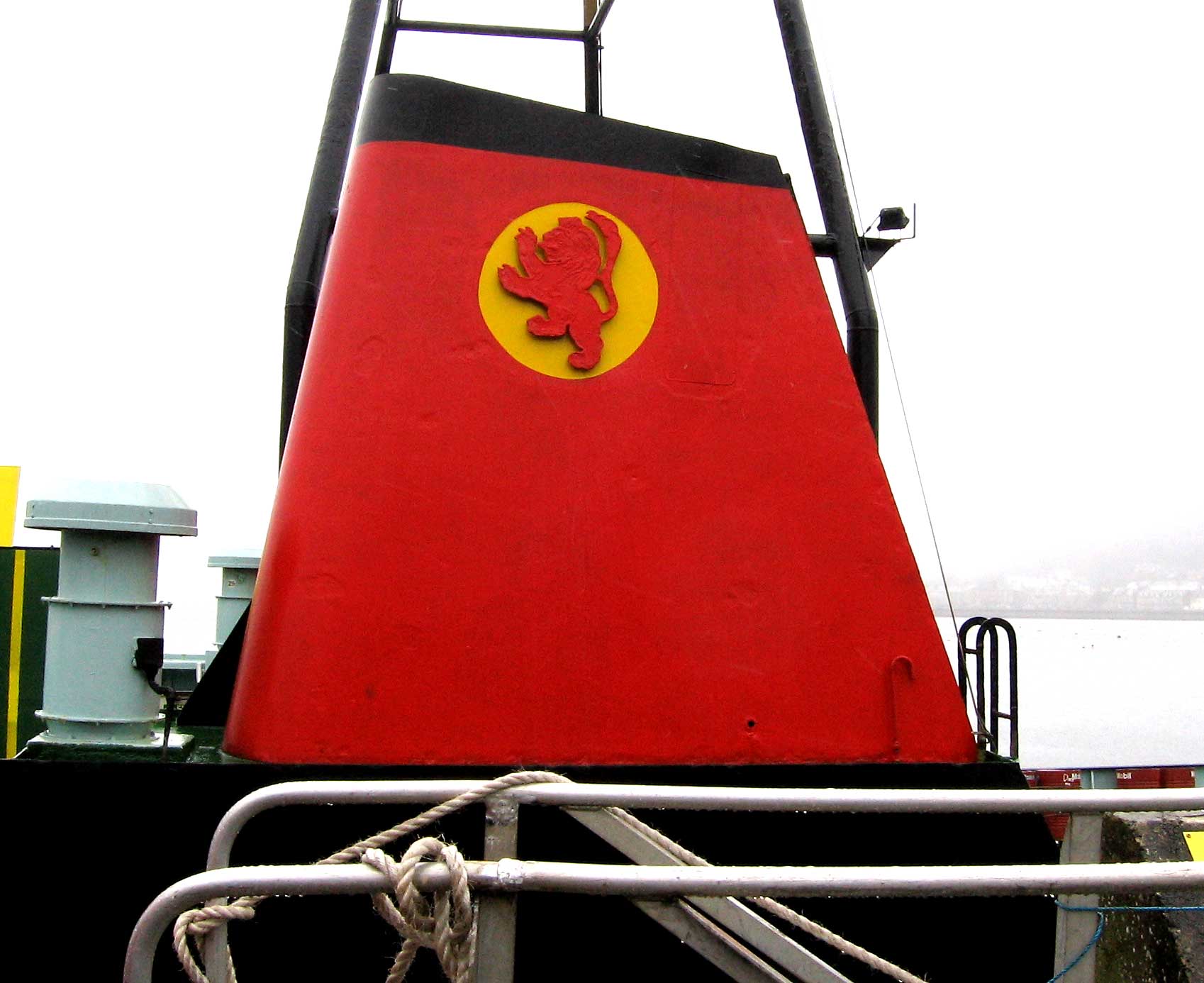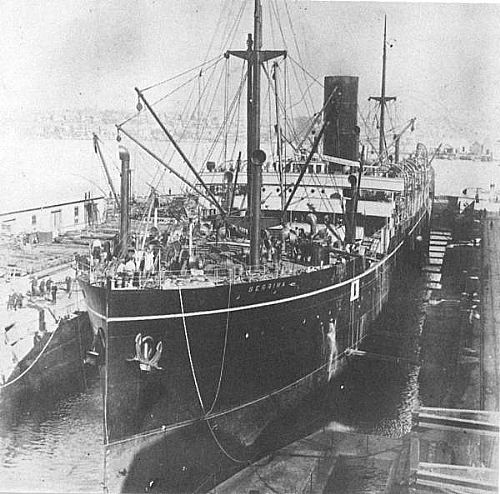|
Caledonian Steam Packet Company
The Caledonian Steam Packet Company provided a scheduled shipping service, carrying freight and passengers, on the west coast of Scotland. Formed in 1889 to complement the services of the Caledonian Railway, the company expanded by taking over rival ferry companies. In 1973, they were merged with MacBraynes as Caledonian MacBrayne. Formation Rival railway companies, the Caledonian Railway (CR), the North British Railway (NBR) and the Glasgow and South Western Railway (GSWR) at first used the services of various early private operators of Clyde steamers. The CR failed to attract private ship owners to their new extension from Greenock to the fishing village of Gourock. They had purchased the harbour at Gourock, which had advantages of a faster line from Glasgow, bypassing the Glasgow and South Western Railway Prince's Pier at Greenock, and being closer to the Clyde resorts. The CR began operating steamers on its own account in 1889. The Caledonian Steam Packet Company (CSP) was f ... [...More Info...] [...Related Items...] OR: [Wikipedia] [Google] [Baidu] |
Caledonian MacBrayne
Caledonian MacBrayne ( gd, Caledonian Mac a' Bhriuthainn), usually shortened to CalMac, is the major operator of passenger and vehicle ferries, and ferry services, between the mainland of Scotland and 22 of the major islands on Scotland's west coast. Since 2006, the company's official name has been CalMac Ferries Ltd, although it still operates as Caledonian MacBrayne. In 2006, it also became a subsidiary of holding company David MacBrayne, which is owned by the Scottish Government. History David MacBrayne MacBrayne's, initially known as David Hutcheson & Co., began in 1851 as a private steamship operator when G. and J. Burns, operators of the largest of the Clyde fleets, decided to concentrate on coastal and transatlantic services and handed control of their river and Highland steamers to a new company in which Hutcheson, their manager of these services, became senior partner. One of the other partners was David MacBrayne (1817-1907), nephew of Messrs. Burns. In 1878, th ... [...More Info...] [...Related Items...] OR: [Wikipedia] [Google] [Baidu] |
Kyleakin
Kyleakin (; Scottish Gaelic: ''Caol Àcain'') is a village situated on the east coast of the Isle of Skye in the Inner Hebrides, Scotland. The village is along the strait of Kyle Akin opposite the northwest Scottish mainland town of Kyle of Lochalsh. Kyleakin is within the parish of Strath. History The etymology of Kyleakin is disputed. The most popular account is that the name is derived from 'Strait of Haakon' named after the King Haakon IV of Norway whose fleet moored there prior to the Battle of Largs in 1263 which ended Norwegian rule of the island. Another possible origin from Acunn, a Celtic mythological hero. In the early 19th century, Lord Macdonald conceived a grandiose plan for the development of Kyleakin, to be re-christened "New Liverpool". A contemporary print, intended to illustrate his plans, shows row upon row of tenement buildings but the project never came to fruition. The village of Kyleakin is also the site of Castle Moil, an ruined fortress built in ... [...More Info...] [...Related Items...] OR: [Wikipedia] [Google] [Baidu] |
Naval Mine
A naval mine is a self-contained explosive device placed in water to damage or destroy surface ships or submarines. Unlike depth charges, mines are deposited and left to wait until they are triggered by the approach of, or contact with, any vessel or a particular vessel type, akin to anti-infantry vs. anti-vehicle mines. Naval mines can be used offensively, to hamper enemy shipping movements or lock vessels into a harbour; or defensively, to protect friendly vessels and create "safe" zones. Mines allow the minelaying force commander to concentrate warships or defensive assets in mine-free areas giving the adversary three choices: undertake an expensive and time-consuming minesweeping effort, accept the casualties of challenging the minefield, or use the unmined waters where the greatest concentration of enemy firepower will be encountered. Although international law requires signatory nations to declare mined areas, precise locations remain secret; and non-complying individuals ... [...More Info...] [...Related Items...] OR: [Wikipedia] [Google] [Baidu] |
William Denny And Brothers
William Denny and Brothers Limited, often referred to simply as Denny, was a Scotland, Scottish shipbuilder, shipbuilding company. History The shipbuilding interests of the Denny family date back to William Denny (born 1779), for whom ships are recorded being built in Dumbarton as far back as 1811 such as the sailing sloop ''Alpha''.) By 1823 the company name had changed to William Denny & Son. The first ship it built under this name was the paddle steamer ''Superb''. From 1845 the company became Denny Brothers (this being William jnr, Alexander and Peter Denny, Peter), and in 1849 the firm was reconstituted as William Denny & Brothers, this being William, James and Peter Denny. Although the Denny yard was situated near the junction of the River Clyde and the River Leven, Dunbartonshire, River Leven, the yard was on the Leven. The founder developed the company's interests in ship owning and operation with interests in the British & Burmese Steam Navigation Company, the Irrawadd ... [...More Info...] [...Related Items...] OR: [Wikipedia] [Google] [Baidu] |
List Of Shipwrecks In November 1915
The list of shipwrecks in November 1915 includes ship A ship is a large watercraft that travels the world's oceans and other sufficiently deep waterways, carrying cargo or passengers, or in support of specialized missions, such as defense, research, and fishing. Ships are generally distinguishe ...s sunk, foundered, grounded, or otherwise lost during November 1915. 1 November 2 November 3 November 4 November 5 November 6 November 7 November 8 November 9 November 10 November 11 November 12 November 13 November 14 November 15 November 16 November 17 November 18 November 19 November 20 November 21 November 22 November 23 November 24 November 25 November 26 November 27 November 28 November 29 November 30 November Unknown date References {{DEFAULTSORT:List of ... [...More Info...] [...Related Items...] OR: [Wikipedia] [Google] [Baidu] |
Lithgows
Lithgows Limited is a family-owned Scottish company that had a long involvement in shipbuilding, based in Kingston, Port Glasgow, on the River Clyde in Scotland. It has a continued involvement in marine resources. History Founding The Company was established by Joseph Russell and his partners Anderson Rodger and William Lithgow who leased the Bay Yard in Port Glasgow from Cunliffe & Dunlop and started trading as Russell & Co. in 1874. In 1879 they purchased the Cartsdyke Mid Yard from J.E. Scott and in 1881 they acquired the Kingston Shipyard from Henry Murray. The partnership was dissolved in 1891: Russell retired, Rodger took the Bay Yard and Lithgow the Kingston and Cartsdyke Yards. In 1900 the Cartsdyke Yard was sold to Greenock Dockyard. Then in 1908 brothers William Lithgow's sons, James and Henry, assumed control; they bought the Bay yard in 1911. The Company then entered a period of expansion by acquisition, buying the Port Glasgow East Yard from ''Robert Duncan & ... [...More Info...] [...Related Items...] OR: [Wikipedia] [Google] [Baidu] |
Caird & Company
Caird & Company was a Scottish shipbuilding and engineering firm based in Greenock. The company was established in 1828 by John Caird when he received an order to re-engine Clyde paddle-tugs. John's relative James Tennant Caird joined the company in 1831, and after leaving to work for Randolph, Elder & Co in Glasgow, rejoined the family business for good in 1838. A year after the death of Robert Caird, the company was sold to Harland & Wolff Ltd in 1916 for £432,493. The firm continued trading as a separate enterprise, with Arthur and Patrick Caird on the board, until 1922. The Arthur Street engine works was sold to John G. Kincaid & Company in 1919. Ships fitted with engines by Caird & Co In the early years Caird & Co were responsible for fitting (or re-fitting) steam engines in ships. An example of this is the ''Glasgow'' fitted with a side-lever engine by Caird & Co in 1828 for G & J Burns. This being an engine running on only 5psi steam pressure, as was common at the t ... [...More Info...] [...Related Items...] OR: [Wikipedia] [Google] [Baidu] |
Barclay Curle
Seawind Barclay Curle is a British shipbuilding company. History The company was founded by Robert Barclay at Stobcross in Glasgow, Scotland during 1818.Grace's Guide: Barclay Curle In 1862, the company built a large engineering works at Stobcross in Glasgow. In 1876, the company moved their yard down the river to . It was incorporated in 1884 as ''Barclay Curle''. In 1912, Barclay Curle acquired the nearby Elderslie Shipyard in from John Shearer & Sons, to take the excess orders that the firm's existing Clydeholm yard in Whiteinch could not ... [...More Info...] [...Related Items...] OR: [Wikipedia] [Google] [Baidu] |
Paddle Steamer
A paddle steamer is a steamship or steamboat powered by a steam engine that drives paddle wheels to propel the craft through the water. In antiquity, paddle wheelers followed the development of poles, oars and sails, where the first uses were wheelers driven by animals or humans. In the early 19th century, paddle wheels were the predominant way of propulsion for steam-powered boats. In the late 19th century, paddle propulsion was largely superseded by the screw propeller and other marine propulsion systems that have a higher efficiency, especially in rough or open water. Paddle wheels continue to be used by small, pedal-powered paddle boats and by some ships that operate tourist voyages. The latter are often powered by diesel engines. Paddle wheels The paddle wheel is a large steel framework wheel. The outer edge of the wheel is fitted with numerous, regularly spaced paddle blades (called floats or buckets). The bottom quarter or so of the wheel travels under water. An ... [...More Info...] [...Related Items...] OR: [Wikipedia] [Google] [Baidu] |
David MacBrayne Ltd
David MacBrayne is a limited company owned by the Scottish Government. Formed in 1851 as the private shipping company David Hutcheson & Co. with three partners, David Hutcheson, Alexander Hutcheson and David MacBrayne, it passed in 1878 to David MacBrayne. It became the main carrier for freight and passengers in the Hebrides, with a co-ordinated network of shipping, road haulage and bus operations. In 1973, it was merged with Caledonian Steam Packet Company as state-owned Caledonian MacBrayne. Since 2006 it has been the holding company for ferry operators CalMac Ferries Ltd (operating as Caledonian MacBrayne) and Argyll Ferries, and is classified as an executive non-departmental public body of the Scottish Government. Formation In 1851, Burns Brothers, G. and J. Burns of Glasgow, passed their fleet of Hebridean vessels to their chief clerk, David Hutcheson. David Hutcheson was married to Margaret Dawson, who was born at her parents home 'Bonnytoun House' in Linlithgow. She wa ... [...More Info...] [...Related Items...] OR: [Wikipedia] [Google] [Baidu] |
Ardrishaig
Ardrishaig ( gd, Àird Driseig) is a coastal village on Loch Gilp, at the southern (eastern) entrance to the Crinan Canal in Argyll and Bute in the west of Scotland. It lies immediately to the south of Lochgilphead, with the nearest larger town being Oban. History ''Àird Driseig'' or ''Rubha Àird Driseig'', the Scottish Gaelic versions of the name, mean "height of the small bramble" or "promontory of the small bramble". Ardrishaig harbour's first pier was built in 1873. In the 1970s, the village was significantly altered when a row of old houses and shops on the lochside of the main street was demolished to make way for a car park. Most trading now takes place in the neighbouring town Lochgilphead. The village was a filming location for the television series ''A Mug's Game''. Governance Ardrishaig historically fell within the South Knapdale parish, and is now served by Ardrishaig Community Council. It has been administered since 1996 by Argyll and Bute Council, falling ... [...More Info...] [...Related Items...] OR: [Wikipedia] [Google] [Baidu] |









